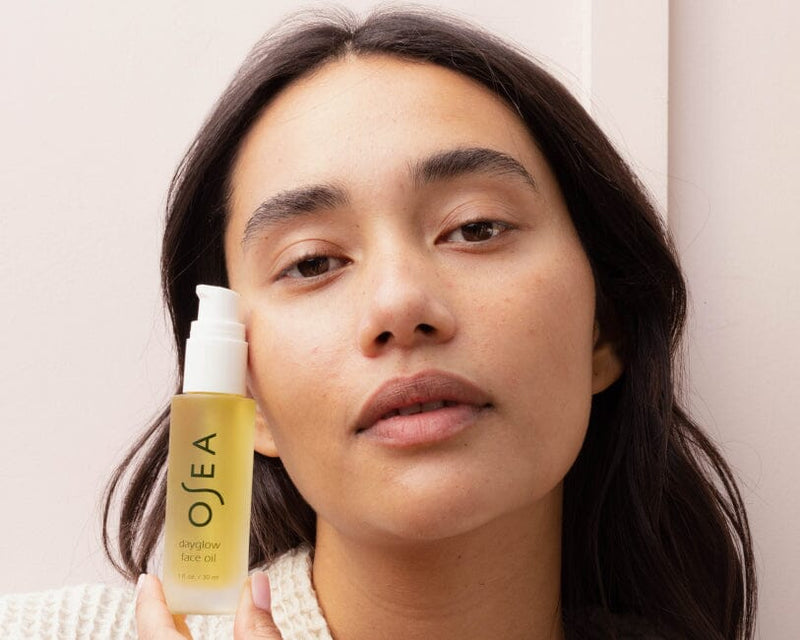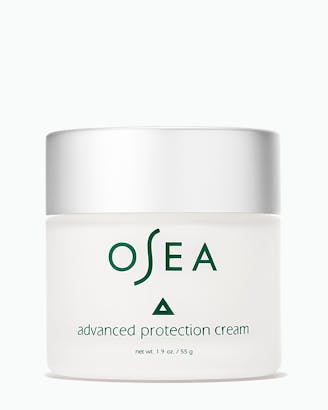Written by OSEA Staff | Published February 1, 2023
Social media has a reputation for allowing questionable skincare advice to circulate, so videos of people slathering their faces with petroleum jelly before bed might seem like a trend designed for clicks instead of results. But dermatologists suggest this might be one time it’s okay to say, “TikTok made me do it.”
Layering petroleum jelly or ointment over your regular nighttime skincare products is also known as slugging. Why is it called slugging? The name refers to the trail slugs and snails leave behind—your skin will get the same sheen, so it looks healthy and glowing.
Before you start piling on the products, there are a few things you need to know about slugging the right way.
Why Would Anyone Want to Try Slugging?
“Always wash your face before bed!”
If there’s one skincare tip we’ve all heard over and over again, it’s that we should go to bed with clean skin. For most of us, going to bed with a slick, goopy face covered in ointment or petroleum jelly just sounds wrong. But versions of this practice have existed for generations across a variety of cultural groups¹.
Still not sold on petroleum? We don’t blame you. However, dermatologists point out that the final layer of slugging uses a highly occlusive product², so you could use a naturally derived oil instead. “Occlusive” just means the product creates a barrier that prevents moisture from escaping and skin-damaging contaminants, like free radicals and pollution, from getting in.
Adding a thin layer of our Essential Hydrating Oil or Dayglow Face Oil® to your skincare routine after cleansing and applying other treatments and moisturizers helps your skin retain moisture and other valuable ingredients because it prevents water from evaporating. Slugging also helps support the skin’s lipid barrier, making it stronger and more resistant to damage³.
How to Start a Slugging Routine (and Why)
If moisturizer is already part of your skincare routine, adding an occlusive layer might sound like overkill. However, slugging skincare can make your moisturizer work better by locking in that hydration. The thicker products won’t moisturize your skin on their own—but they can leave your skin feeling softer, fresher, and more supple because they make the moisturizer more effective.
Convinced and ready to give it a try? Here’s how to get started.
1. Cleansing
Although occlusive products won’t clog pores³, they will hold in anything that’s already on your skin, including pore-clogging dirt and makeup. It’s critical that your skin is as clean as possible before applying any additional products. Try our Ocean Cleanser for a gentle but thorough cleanse, or the Cleansing Mudd with tea tree and peppermint for an exfoliating deep clean that eliminates impurities from pores.
2. Applying Serum and Moisturizer
Once your skin is clean, apply a layer of Hyaluronic Sea Serum for a clinically proven hydration boost that reduces the signs of aging. A humectant-based moisturizer, like our Advanced Protection Cream, provides plenty of nourishing hydration. We love that this cream is packed with sea minerals that help skin soft and hydrated for a smoother, more radiant look.
3. Add Your Occlusive Layer
After moisturizing, apply your favorite OSEA oil. You don’t need a thick, heavy layer—a little goes a long way because it’s easy to spread on the skin. You also don’t have to cover your whole face. Try slugging just areas that need it the most, like especially dry patches or on thin skin that shows more signs of aging.
4. Wait 30 Minutes
Give the products a chance to sink in before heading to bed. You may want to sleep with a towel or cloth over your pillowcase so it doesn’t absorb any of the product. Tying your hair back or covering it will also keep it away from the oil.
After a good night’s sleep, wash your face with a gentle cleanser to remove any residue.
How Often Should You Slug?
Unless you have extra-dry skin, you probably don’t need to slug more than a few times a week. Dermatologists are more likely to recommend slugging as a short-term or seasonal skincare strategy⁴.
And if you have especially oily or acne-prone skin, you might want to skip slugging altogether. You already have a healthy—or even overactive—lipid layer that doesn’t need the extra moisture boost. This means slugging could worsen acne because the excess moisture is locked in.
If you have dry skin and want to give your skincare routine a quick makeover, try slugging—it’s one TikTok trend you won’t want to scroll past.
Citations
1. Roberts, S., Valenski, A. et. al. (18 August 2022). What is Slugging Skin—And Should You Be Doing It? The Skimm. Retrieved on February 27, 2023, from https://www.theskimm.com/wellness/slugging-skin
2. What is Slugging and Should You Try It? Cleveland Clinic. Retrieved on February 27, 2023, from https://health.clevelandclinic.org/slugging/
3. Palermino, C. (14 December 2022). “Slugging” Is the Skincare Trend Going Viral on Reddit. Byrdie. Retrieved on February 27, 2023, from https://www.byrdie.com/slugging-skincare-trend-5087545
4. Quinn, D. (6 November 2022). Here’s What Dermatologists Have to Say About the Skincare Slugging Trend. RealSimple. Retrieved on February 27, 2023, from https://www.realsimple.com/beauty-fashion/skincare/skincare-slugging
 Body Oil
Body Oil
 Body Moisturizers
Body Moisturizers
 Cleansers
Cleansers
 Body Scrubs
Body Scrubs
 Face Moisturizers
Face Moisturizers
 Travel & Sets
Travel & Sets







